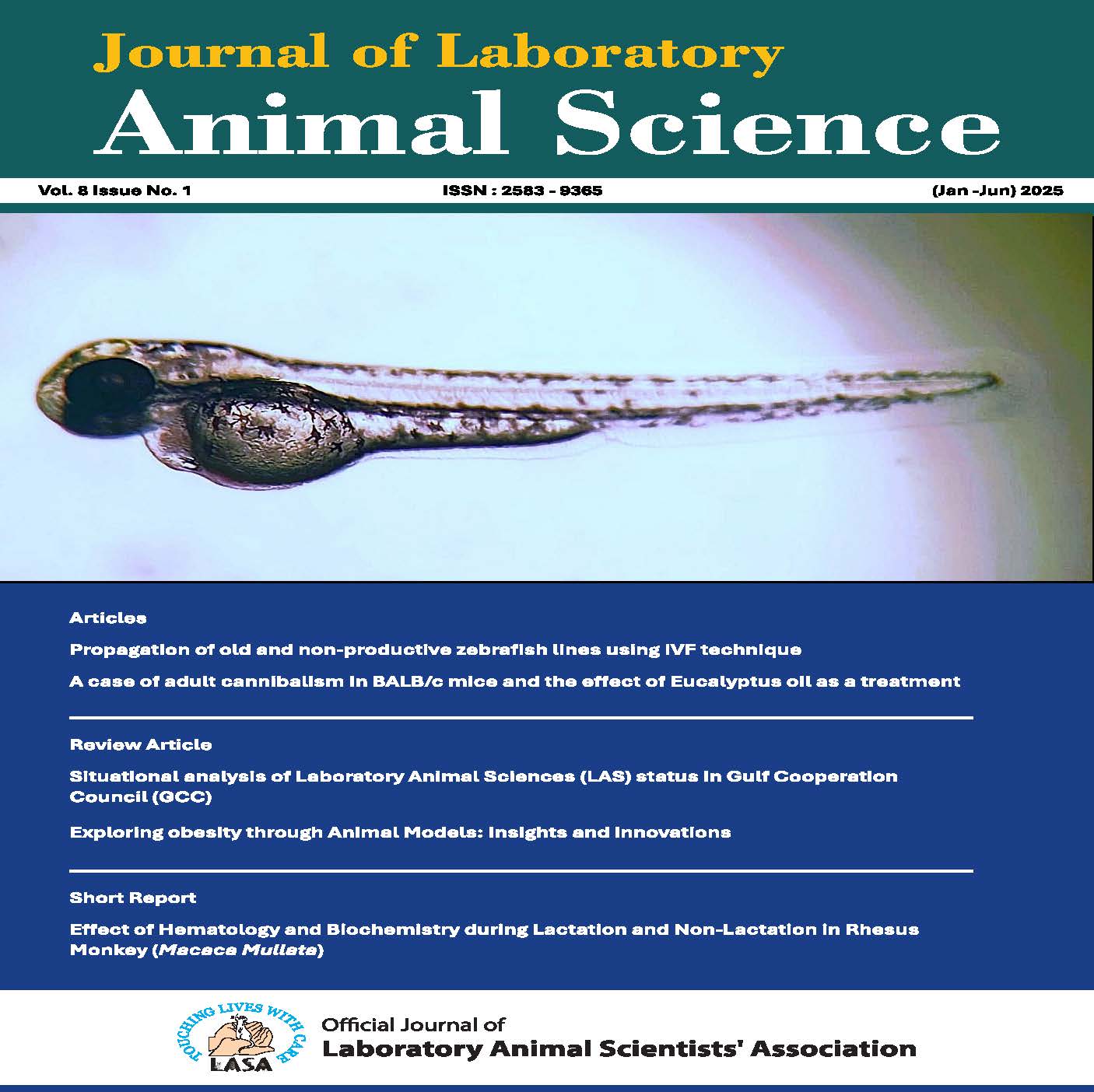Quality Assessment of Treated Reverse Osmosis Drinking Water in a Specific Pathogen Free Rodent Barrier
DOI:
https://doi.org/10.48165/jlas.2025.8.2.5Keywords:
Drinking water, Heterotrophic bacteria, Pseudomonas, aeruginosa, Reverse osmosis, Water qualityAbstract
This study investigated the quality of treated reverse osmosis drinking water in a specific pathogen free rodent facility. The water bottles placed in the animal rooms were evaluated on days 10, 14, and 21 for room-level assessment. For cage-level assessment, the water was stored for 14 days inside the room and then evaluated on days 2 and 5 (group A – 5 mice) and days 2, 5, 7, 9, and 14 (group B – 2 mice) after provision to the mice in individually ventilated cages. At the room level, a significant decrease in free chlorine was observed from days 10 to 21 (p<0.0001). The concentrations of heterotrophic bacteria and Pseudomonas aeruginosa were consistently low (<1 CFU/mL and <1 CFU/100 mL, respectively). Cagelevel assessment revealed a significant decrease in free chlorine at days 7 (p = 0.0291) and 14 (p = 0.0231) for Group B. Adenosine triphosphate was detected on days 2 and 5 (Group A) and days 5, 7, 9, and 14 (Group B). Heterotrophic bacteria were found in Group A, day 5 (460 CFU/mL), and Group B, days 9 (2 CFU/mL) and 14 (2000 CFU/mL). The level of Pseudomonas aeruginosa remained low in both groups. There was no significant change in the pH at the room or cage level. The findings suggest that water bottles filled with treated reverse osmosis water can be stored unused in rooms for 14 days before being distributed to cages with at most two animals for 7 days. For higher stocking densities, it is recommended to change water bottles every two days.
Downloads
References
Allen, E. D., Czarra, E. F., & DeTolla, L. (2018). Water quality and water delivery systems. In R. H. Weichbrod, G. A. H. Thompson, & J. N. Norton (Eds.), Management of animal care and use programs in research, education, and testing (2nd ed., Chap. 28). CRC Press/Taylor & Francis.
Bartram, J., Cotruvo, J. A., Exner, M., Fricker, C., Glasmacher, A., & World Health Organization. (2003). Heterotrophic plate counts and drinking-water safety: The significance of HPCs for water quality and human health (No. 12). World Health Organization.
Bywater, J. E. C., & Kellett, B. S. (1977). Inhibition of bacteria in mouse drinking water by chlorination. Laboratory Animals, 11(4), 215–217.
Chowdhury, S. (2012). Heterotrophic bacteria in drinking water distribution system: A review. Environmental Monitoring and Assessment, 184(10), 6087–6137.
Edstrom Industries. (2015). Chlorination of drinking water. Waterford, WI: Edstrom Industries.
Ferrecchia, C. E., Jensen, K., & Van Andel, R. (2014). Intracage ammonia levels in static and individually ventilated cages housing C57BL/6 mice on 4 bedding substrates. Journal of the American Association for Laboratory Animal Science, 53(2), 146–151.
Fox, J. G., Anderson, L. C., Otto, G., Pritchett-Corning, K. R., & Whary, M. T. (Eds.). (2015). Laboratory animal medicine (3rd ed.). San Diego, CA: Academic Press.
Gonzalez, D. M., Graciano, S. J., Karlstad, J., Leblanc, M., Clark, T., Holmes, S., & Reuter, J. D. (2011). Failure and life cycle evaluation of watering valves. Journal of the American Association for Laboratory Animal Science, 50(5), 713–718.
Gordon, A., & Wyatt, J. (2011). The water delivery system affects the rate of weight gain in C57BL/6J mice during the first week after weaning. Journal of the American Association for Laboratory Animal Science, 50(1), 37–40.
Haist, C., Cadillac, J., & Dysko, R. (2004). Assessment of bacterial contamination of drinking water provided to mice. Contemporary Topics in Laboratory Animal Science, 43(6), 8–13.
Hygiena Technical Sheet. (2014). Directions for use - Aquasnap™ Total & Aquasnap™ Free ATP tests for water samples.
National Research Council (US) Committee for the Update of the Guide for the Care and Use of Laboratory Animals. (2011). Guide for the care and use of laboratory animals (8th ed.). Washington, DC: National Academies Press.
Peveler, J. L., Crisler, R., & Hickman, D. (2015). Quality testing of autoclaved rodent drinking water during short-term and long-term storage. Lab Animal, 44(6), 211–215.
Saalidong, B. M., Aram, S. A., Otu, S., & Lartey, P. O. (2022). Examining the dynamics of the relationship between water pH and other water quality parameters in ground and surface water systems. PLOS ONE, 17(1).
Sheikhi, R., Alimohammadi, M., Askari, M., & Moghaddasian, M. S. (2014). Decay of free residual chlorine in drinking water at the point of use. Iranian Journal of Public Health, 43(4), 535–536.
Tataryn, N. M., Buckmaster, C. A., Schwiebert, R. S., & Swennes, A. G. (2021). Comparison of four beddings for ammonia control in individually ventilated mouse cages. Journal of the American Association for Laboratory Animal Science, 60(1), 37–43.

